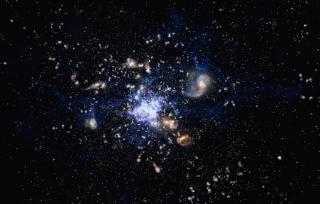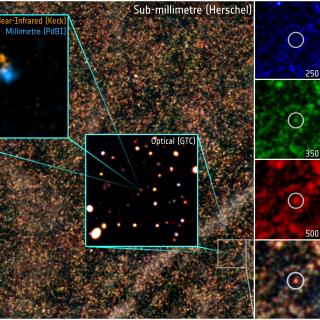Borsato, E.; Marchetti, L.; Negrello, M.; Corsini, E. M.; Wake, D.; Amvrosiadis, A.; Baker, A. J.; Bakx, T. J. L. C.; Beelen, A.; Berta, S.; Beyer, A.; Clements, D. L.; Cooray, A.; Cox, P.; Dannerbauer, H.; de Zotti, G.; Dye, S.; Eales, S. A.; Enia, A.; Farrah, D.; Gonzalez-Nuevo, J.; Hughes, D. H.; Ismail, D.; Jin, S.; Lapi, A.; Lehnert, M. D.; Neri, R.; Pérez-Fournon, I.; Riechers, D. A.; Rodighiero, G.; Scott, D.; Serjeant, S.; Stanley, F.; Urquhart, S.; van der Werf, P.; Vaccari, M.; Wang, L.; Yang, C.; Young, A.
Bibliographical reference
Monthly Notices of the Royal Astronomical Society
Advertised on:
3
2024
Citations
12
Refereed citations
8
Description
We have carried out Hubble Space Telescope (HST) snapshot observations at 1.1 μm of 281 candidate strongly lensed galaxies identified in the wide-area extragalactic surveys conducted with the Herschel Space Observatory. Our candidates comprise systems with flux densities at $500\, \mu$m, S500 ≥ 80 mJy. We model and subtract the surface brightness distribution for 130 systems, where we identify a candidate for the foreground lens candidate. After combining visual inspection, archival high-resolution observations, and lens subtraction, we divide the systems into different classes according to their lensing likelihood. We confirm 65 systems to be lensed. Of these, 30 are new discoveries. We successfully perform lens modelling and source reconstruction on 23 systems, where the foreground lenses are isolated galaxies and the background sources are detected in the HST images. All the systems are successfully modelled as a singular isothermal ellipsoid. The Einstein radii of the lenses and the magnifications of the background sources are consistent with previous studies. However, the background source circularized radii (between 0.34 and 1.30 kpc) are ~3 times smaller than the ones measured in the sub-millimetre/millimetre for a similarly selected and partially overlapping sample. We compare our lenses with those in the Sloan Lens Advanced Camera for Surveys (ACS) Survey confirming that our lens-independent selection is more effective at picking up fainter and diffuse galaxies and group lenses. This sample represents the first step towards characterizing the near-infrared properties and stellar masses of the gravitationally lensed dusty star-forming galaxies.
Related projects

Molecular Gas and Dust in Galaxies Across Cosmic Time
Two of the most fundamental questions in astrophysics are the conversion of molecular gas into stars and how this physical process is a function of environments on all scales, ranging from planetary systems, stellar clusters, galaxies to galaxy clusters. The main goal of this internal project is to get insight into the formation and evolution of
Helmut
Dannerbauer

Formation and Evolution of Galaxies: Observations in Infrared and other Wavelengths
This IAC research group carries out several extragalactic projects in different spectral ranges, using space as well as ground-based telescopes, to study the cosmological evolution of galaxies and the origin of nuclear activity in active galaxies. The group is a member of the international consortium which built the SPIRE instrument for the
Ismael
Pérez Fournon